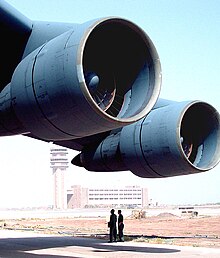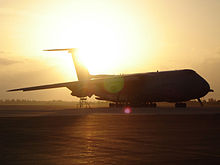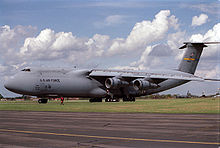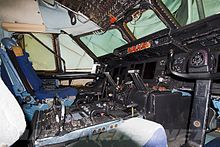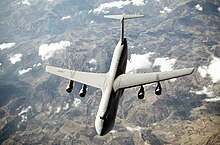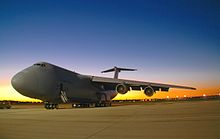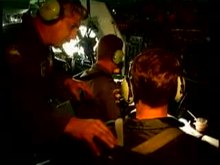Lockheed C-5
| Lockheed C-5 Galaxy | |
|---|---|
 A US Air Force C-5A "Galaxy" |
|
| Type: | four-engine strategic transporter |
| Design country: | |
| Manufacturer: | |
| First flight: |
June 30, 1968 |
| Commissioning: |
June 1970 |
| Production time: |
|
| Number of pieces: |
131 |
The Lockheed C-5 Galaxy is a military wide-body transport aircraft that was developed for the US Air Force in the early 1960s and is still in service there today. Until the completion of the Soviet Antonov An-124 Ruslan , it was the largest aircraft in the world. Of the 131 copies produced, 73 were still in service with the US Air Force at the end of 2012 .
history
development
In the early 1960s, the US Air Force commissioned design studies for a new type of strategic long-range transport aircraft. The aim was to replace the old Douglas C-133 Cargomaster and to supplement the existing, but too small Lockheed C-141 Starlifters . The procurement of up to 200 machines was planned. The technical requirements of the project, now called Cargo Experimental Heavy Logistics System (CX-HLS), were very high from the start:
- a maximum payload of over 100 tons, more than twice as high as that of the C-141
- intercontinental reach
- a large cargo hold accessible from both ends of the hull for short handling times
- Takeoff fully loaded from 8,000 feet (2,438 m) runway length; Landing on 4,000 feet (1,219 m) of semi-paved runway
The aircraft manufacturers Boeing , Douglas , General Dynamics , Lockheed and Martin Marietta submitted designs for the aircraft, as did General Electric , Curtiss-Wright and Pratt & Whitney for the engines. After a pre-selection, Boeing, Douglas and Lockheed were allowed to continue their design studies for the aircraft and General Electric and Pratt & Whitney for the engines.
Procurement
In August 1965, General Electric was initially awarded the contract to develop the engines . With an estimated total weight of 350 t and the planned four engines, each engine had to be able to develop the enormous thrust of around 180 kN for the time . In October 1965 Lockheed - who had just built the C-141 - finally got the production order for 115 machines of the in-house L-500 and the aircraft known by the Air Force as the C-5A Galaxy . Although Boeing's draft was favored by the evaluation committee for technical reasons, the Department of Defense under Robert McNamara chose Lockheed - their offer was the cheapest. The final designs by Boeing and Douglas had, unlike the design of the L-500, a conventional tail fin and also differed from the victorious Lockheed design, which had an upward-opening bow door, with side-opening bow doors.
One of Boeing's designs also had a shortened upper deck, which gave the aircraft a hump. A short time later, the idea of the hump flowed into the planning of the Boeing 747 .
production
The first flight took place on June 30, 1968 at Dobbins Air Force Base in Georgia . The first C-5A was delivered in December 1969, and the Military Airlift Command (MAC) reported it to be operational in September 1970.
At the time, the Galaxy was the largest aircraft in the world, it was not until December 1982 that it was overtaken by its Soviet counterpart Antonov An-124 Ruslan . Although this is 6 m shorter than the C-5 , it has a larger wingspan, a higher loading capacity and a higher take-off weight . The Antonov An-225 has been the largest aircraft since 1988 . On September 13, 2009, a C-5M set 41 world records ( filed with the FAI ) in the C-1.S class in one flight; z. B. 80 t payload in 24 minutes at an altitude of 12 km.
Right from the start there were problems with the costs and the technology of the project. The American press considered the need for such an aircraft to be artificially created in order to provide the aviation industry with billions in tax-financed contracts, which in turn would benefit politicians and the military. The whole thing developed into the first major procurement scandal in the US defense industry.
The implementation of the all too ambitious requirements resulted in such high development costs that the price of a copy of the Galaxy continued to rise: from the estimated 16.5 to 60 million US dollars. In November 1969 the US Air Force pulled the emergency brake and reduced the order from 115 to 81 machines.
After all, tests and the first missions soon showed that the C-5 did not meet the requirements placed on it - especially the range with a high payload. It turned out that parts of the wing structure had been designed too weakly and reinforcing the wings would cost around 2 billion US dollars. The consequences were in some cases drastic flight restrictions for payload (no 100 t possible) or range and the resulting lengthy and costly conversion program that culminated in the redesign and replacement of the wings of all around 80 C-5A by 1987.
In the early 1980s, the US government decided as part of the arms program under President Ronald Reagan to procure another 50 units of the series. The positive experience during Operation Nickel Grass also contributed to this decision . So Lockheed resumed production for the improved Model C-5B . Their first flight took place on September 10, 1985, the machines were delivered from January 1986 to April 1989.
From the beginning, Lockheed tried to win other customers for their transporter besides the military, but was unsuccessful. These circumstances earned the Galaxy the nickname FRED , which stands for Fantastic Ridiculous Economic Disaster (in German: crazy ridiculous economic failure ).
modernization
Since 2004, 52 C-5 Galaxys have undergone extensive modernizations in order to increase their reliability and service life and thus enable a service life until 2040. The modernization is divided into two programs. First, the machines go through the “Avionics Modernization Program” (C-5 AMP), the planning of which had already started in 1998. AMP included the complete replacement of the avionics , the installation of a "Global Air Traffic Management System", improvements in the communication and navigation systems, new cockpit displays and safety equipment, as well as the installation of a new autopilot.
After the AMP, the machines go through the "Reliability Enhancement and Re-engining Program" (C-5 RERP). The focus is on replacing the engines: they were replaced by the F138-GE-100 with up to 222.41 kN thrust , which corresponds to a thrust increase of 22% and leads to significantly improved flight performance (among other things, the required runway could be 30%, the time to reach cruising altitude is reduced by 38%). The F138-GE-100 is a variant of the civil General Electric CF6 -80C2, which also powers the Boeing 747-400 . Lockheed Martin also works on the pylons, auxiliary engines, wings, landing flaps, cockpit and hydraulic system. The revised machines are called the C-5M Super Galaxy. On June 19, 2006, the first completely rebuilt aircraft made its maiden flight at Dobbins Air Reserve Base, Georgia .
A total of one C-5A, 49 C-5B and both C-5C will be converted into C-5M Super Galaxys. Originally, all C-5A were also to be rebuilt, but since the costs rose from 11.1 billion US dollars estimated in November 2001 to 17.5 billion by the end of 2007, this project was abandoned (with the exception of a C-5A, which had already been rebuilt at this point). As a replacement, the fleet of the Boeing C-17 Globemaster III was enlarged . The complete modernization of all remaining C-5 Galaxies could be completed in summer 2018, whereby the total costs should be 7.7 billion US dollars. Lockheed delivered the last C-5M Super Galaxy on August 2, 2018.
commitment

A total of 131 C-5 machines were built, six of which have so far been lost in accidents. The aircraft in service are in service with the Air Mobility Command (AMC), the Air National Guard (ANG) and the Air Force Reserve Command (AFRC). Since entering service in 1970, the C-5 has participated in virtually all major air transport operations of the US Air Force. Despite all the technical problems, the C-5 Galaxy quickly proved to be indispensable at the USAF, because it can be used to transport even bulky military equipment or troops quickly and - through aerial refueling - to every corner of the world.
Since the early 1990s, it has been increasingly relieved of the Boeing C-17 Globemaster III, which can operate more efficiently than the C-5 in many cases. From November 2003 to November 2011 and February 2014 to December 2015, 42 aircraft from the older A series were decommissioned at the 309th Aerospace Maintenance and Regeneration Group (AMARG). By September 2017, the remaining 33 copies of the A version were also retired. Since a successor model is not yet in development, the remaining machines, which were converted to the C-5M Super Galaxy by 2018, are to remain in service until 2040 .
Technology / design
Shoulder decker
In order to be able to meet the requirements, only a high-wing or shoulder- wing construction was considered from the outset . This has the following advantages:
- The cargo hold is not affected by the center wing.
- The engines can be hung under the wings and still have sufficient distance to the ground. This prevents too much dust from being sucked up when using semi-paved slopes.
This ground clearance is also important for another feature of the Galaxy : In order to facilitate the loading and unloading, the entire aircraft over the can suspension - hydraulic be lowered. In order to keep the ground pressure low on unpaved ground, the weight is distributed over 28 wheels, four of which are on the bow. The main landing gear consists of four supports with six wheels each in a 2 + 4 arrangement.
Two decks
The two openings at the bow (the nose is folded up) and stern are equipped with ramps and winches, which enables short handling times. The hold is 37 m long, 5.8 m wide and 4.1 m high. For example, the C-5 can accommodate several battle tanks , helicopters , rockets or entire trucks in its hold. For passenger transport, up to 270 seats can be mounted on pallets in the main deck, which is pressurized and air-conditioned for this purpose. Above is the upper deck with a pilot's cockpit , rooms for a second crew and couriers, and behind the middle wing is a fully equipped compartment for 75 passengers. This means that the C-5 Galaxy as a troop transport can carry 345 passengers in addition to the crew.
variants
- L-500 : Lockheed's internal model number and designation for unrealized civil versions of the Galaxy.
-
C-5A : First production series; 81 machines were built up to 1973.
- 66-8303 to 66-8307 c / n 500-0001 to 500-0005 (5 pieces)
- 67-0167 to 67-0174 c / n 500-0006 to 500-0013 (8 pieces)
- 68-0211 to 68-0228 c / n 500-0014 to 500-0031 (18 pieces)
- 69-0001 to 69-0027 c / n 500-0032 to 500-0058 (27 pieces)
- 70-0445 to 70-0467 c / n 500-0059 to 500-0081 (23 pieces)
- 70-0468 order withdrawn
- 71-0180 to 71-0212 order withdrawn
- 72-0099 to 71-0112 order withdrawn
-
C-5B : Second production series with 50 machines, delivered from 1986 to 1989. The structural reinforcements that were subsequently required for the C-5A were taken into account from the outset. Also improved avionics and adaptation to the state of the art.
- 83-1285 c / n 500-0082 (1 piece)
- 84-0059 to 85-0062 c / n 500-0083 to 500-0086 (4 pieces)
- 85-0001 to 85-0010 c / n 500-0087 to 500-0096 (10 pieces)
- 86-0011 to 86-0026 c / n 500-0097 to 500-0112 (16 pieces)
- 87-0027 to 86-0045 c / n 500-0113 to 500-0131 (19 pieces)
-
C-5C : Two C-5A were converted to transport space cargo such as satellites and parts of the International Space Station (ISS) . The troop compartment on the upper deck was removed and the tailgate changed so that special containers for space parts that are too big for the C-5A / B fit into the hold.
- 68-0213 c / n 500-0016 (1 piece)
- 68-0216 c / n 500-0019 (1 piece)
- C-5D : Lockheed's draft proposal for the new Galaxys building in the early 1990s, which was not implemented.
- C-5M : From 2004 to 2018, a total of 52 C-5 machines were converted to the C-5M "Super Galaxy" standard for 7.7 billion US dollars. The modernization included new F138-GE-100 engines , new avionics and a heavily redesigned glass cockpit .
Incidents
The following copies of the Galaxy have been lost due to crashes or other accidents:
| date | Mark | Type | description |
|---|---|---|---|
| May 25, 1970 | 67-0172 | C-5A | Destroyed by fire on the ground in Palmdale , California |
| 17th October 1970 | 66-8303 | C-5A | (First C-5 built) Destroyed by fire on the ground at Dobbins AFB , Georgia |
| September 27, 1974 | 68-0227 | C-5A | Destroyed by fire on the ground in Clinton , Oklahoma |
| April 4th 1975 | 68-0218 | C-5A | Crash during an emergency landing in Saigon , Vietnam when a pressure drop occurred after takeoff . 155 of 328 people on board, mostly Vietnamese children, died ( Operation Baby Lift ) |
| August 29, 1990 | 68-0228 | C-5A | Crash immediately after taking off from Ramstein AB , Germany . 13 of the 17 crew members died. |
| April 3, 2006 | 84-0059 | C-5B | Crash due to operator error on landing near Dover AFB , Dover ( Delaware ), all 17 crew members survived. |
Technical specifications
| Parameter | Data from the C-5B Galaxy | Data from the C-5M Super Galaxy |
|---|---|---|
| crew | 5 + max. 15 in the front part of the cabin | |
| length | 75.53 m | |
| span | 67.88 m | |
| Wing area | 575.98 m² | |
| Wing extension | 7.99 | |
| Wing loading | 295 to 659 kg / m² | 299 to 661 kg / m² |
| height | 19.34 m | |
| Cargo space dimensions | Length: 43.80 m, width: 5.79 m, height: 4.11 m | |
| Empty mass | 169,643 kg | 172,370 kg |
| Max. Takeoff mass | 379,657 kg | 381,018 kg |
| Max. Payload | 118,387 kg or up to 345 soldiers | 129,274 kg or up to 345 soldiers |
| Fuel capacity | 193,620 liters | |
| Top speed | 919 km / h (at an altitude of 7,620 m) | 932 km / h (at optimal flight altitude) |
| Marching speed | 880 km / h (at an altitude of 7,620 m) | k. A. |
| Service ceiling | 10,900 m | k. A. |
| Max. Rate of climb | 8.75 m / s | 9.14 m / s |
| Range |
4,440 km (with maximum payload) |
|
| Transfer range | 10,411 km | 12,936 km |
| Takeoff route | 2,600 m | k. A. |
| Landing route | 1,100 m | k. A. |
| Landing speed | 225 km / h | k. A. |
| Engine | four turbofan engines TF39-GE-1C , each 191.34 kN thrust | four turbofan engines F138-GE-100 each with 222.41 kN thrust |
| Thrust-to-weight ratio | 0.21 to 0.46 | 0.24 to 0.53 |
literature
- AERO - The illustrated compilation of aviation. Aerospace Publ. Ltd./Marshall Cavendish International Ltd. 1982-1988, pp. 2476-2483.
- Rice, Berkeley: The C-5A Scandal. Houghton Mifflin Corporation, Boston 1971.
- globalsecurity.org: C-5 Galaxy (English) [1]
- Bill Norton: Warbird Tech Series Volume 36, Lockheed Martin C-5 Galaxy. Specialty Press, North Branch, Minnesota, USA (2003), ISBN 1-58007-061-2 .
Web links
Individual evidence
- ↑ see World Air Forces 2013 ( Memento from December 16, 2012 in the Internet Archive ) at flightglobal.com; PDF, English; Retrieved January 27, 2013
- ↑ a b Globalsecurity.org: C-5 History. Retrieved January 7, 2010 .
- ^ Bill Norton: Warbird Tech Series Volume 36, Lockheed Martin C-5 Galaxy. Specialty Press, North Branch, Minnesota, USA (2003), ISBN 1-58007-061-2 .
- ↑ a b Latest Super Galaxy delivered. Combat Aircraft, November 3, 2016, accessed November 5, 2016 .
- ↑ The last C-5M leaves Marietta. Flugrevue, August 3, 2018, accessed on August 4, 2018 .
- ↑ a b c Lockheed Martin delivers last upgraded C-5. FlightGlobal, August 3, 2018, accessed August 6, 2018 .
- ↑ Airliners.net (English), accessed on February 24, 2016.
- ↑ AMARC Experience ( Memento from February 24, 2016 in the Internet Archive ) (English), accessed on February 24, 2016.
- ↑ AviationSafetyNet: Accident description Lockheed C-5A Galaxy 68-0228 AUG 29, 1990. Retrieved January 7, 2010 .
- ↑ AviationSafetyNet: Accident description Lockheed C-5B Galaxy 84-0059 3 APR 2006. Retrieved January 7, 2010 .

